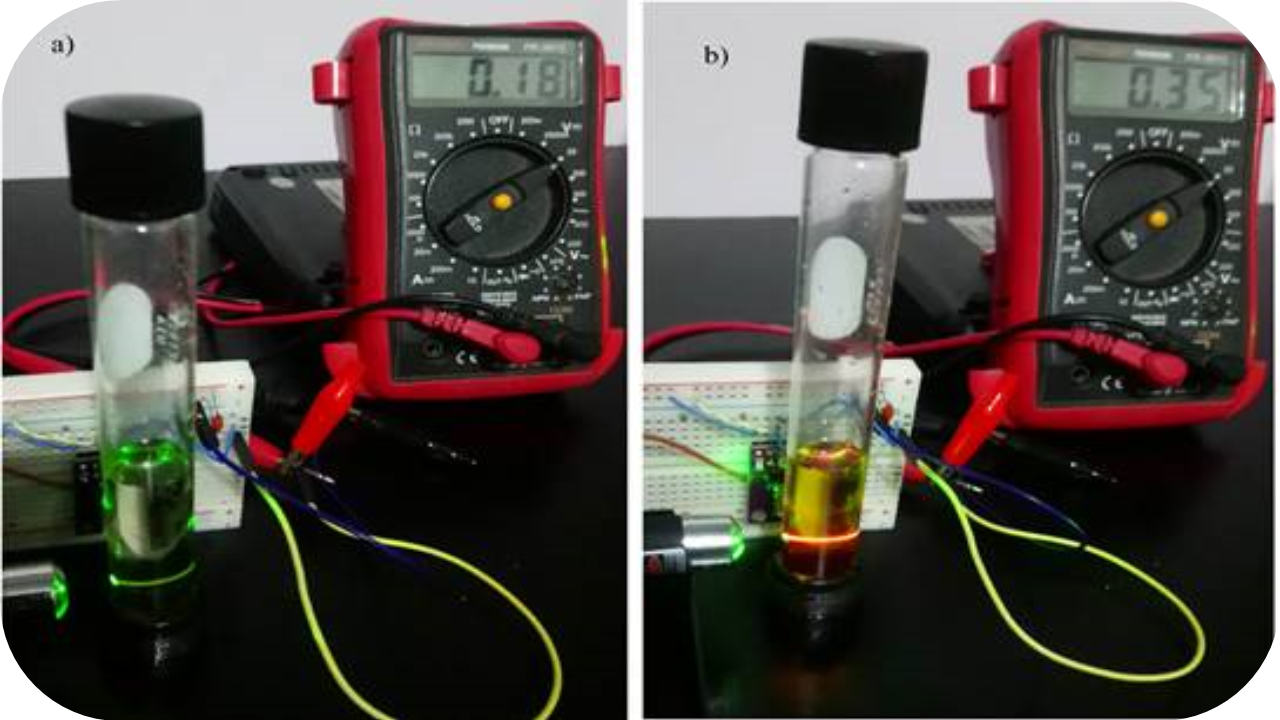Experiencia con el aprendizaje basado en proyectos en la enseñanza de la espectroscopia con grupos interdisciplinarios

DOI
https://doi.org/10.25267/Rev_Eureka_ensen_divulg_cienc.2024.v21.i1.1203Información
Resumen
La enseñanza de la espectroscopia en la iniciación científica universitaria presenta un desafío para los profesores de ciencia, debido a la necesidad de equipos analíticos específicos. Por esta razón, este trabajo propone el diseño de tres prototipos de bajo costo para ser desarrollados por grupos interdisciplinarios conformados por estudiantes universitarios de cuarto ciclo, aplicando el aprendizaje basado en proyectos como metodología educativa para solucionar un problema de adulteración de alimentos. Con este fin, los estudiantes deben identificar un aceite de oliva extra virgen de un aceite vegetal económico empleando los principios de la espectroscopia en sus proyectos.
Palabras clave
Descargas
Agencias de apoyo
Cómo citar
Licencia
Derechos de autor 2024 Julio David Gonzales Balladares, Evelyn Toque-Huaman

Esta obra está bajo una licencia internacional Creative Commons Atribución-NoComercial 4.0.
Aquellos autores/as que tengan publicaciones con esta revista, aceptan los términos siguientes:
- Los autores/as podrán conservar sus derechos de autor y garantizarán a la revista el derecho de primera publicación de su obra, el cual estará simultáneamente sujeto a la Licencia de reconocimiento de Creative Commons que permite a terceros compartir la obra siempre que se indique su autor y su primera publicación esta revista.
- Los autores/as podrán adoptar otros acuerdos de licencia no exclusiva de distribución de la versión de la obra publicada (p. ej.: depositarla en un archivo telemático institucional) siempre que se indique la publicación inicial en esta revista.
- Se permite y recomienda a los autores/as difundir su obra a través de Internet (p. ej.: en archivos telemáticos institucionales o en su página web) una vez el manuscrito sea aceptado, lo cual puede producir intercambios interesantes y aumentar las citas de la obra publicada. (Véase El efecto del acceso abierto). También se permite la difusión de la versión pre-print de los artículos a partir del momento en que son aceptados o publicados
Reconocimiento-NoComercial
CC BY-NC
Citas
Albert, D. R., Todt, M. A., y Davis, H. F. (2012). A low-cost quantitative absorption spectrophotometer. Journal of Chemical Education, 89(11), 1432−1435. https://doi.org/10.1021/ed200829d
Boskou, D. (2009). Culinary applications of olive oil-minor constituents and cooking. In olive oil-minor constituents and health, 1.st ed., editorial., CRC Press. https://doi.org/10.1201/9781420059946
Braniša, J., Jenisová Z., y Jomová, K. (2014). Pigment profile of olive oils determined by school measurement system labquest and spectrometer. Journal of Technology and Information Education, 6(2), 48-57. https://doi.org/10.5507/jtie.2014.017
Bui, D.A., y Hauser, P.C. (2014). Analytical devices based on light-emitting diodes: A review of the state-of-the-art. Analytica Chimical Acta, 853, 46-58. http://dx.doi.org/10.1016/j.aca.2014.09.044
Cid, R., y González-Fernández, D. (2020). Una aproximación a la espectrometría en educación secundaria. Anales de Química, 116(1). 25-29. https://analesdequimica.es/index.php/AnalesQuimica/article/view/1309
Corbacho, A. M. (2018). El aprendizaje interdisciplinario, intensivo e integrado como herramienta para el desarrollo de conocimientos, habilidades y aptitudes en estudiantes de grado. INTERdisciplina, 5(13), 63–85. https://doi.org/10.22201/ceiich.24485705e.2017.13.62384
Giuffrida, D., Salvo, F., Salvo, A., Pera, L., y Dugo, G. (2007). Pigments composition in monovarietal virgin olive oils from various sicilian olive varieties. Food Chemistry, 101, 833–837. https://doi.org/10.1016/j.foodchem.2005.12.030
González, M. A., y Montaño L. M. (2015). La espectroscopia y su tecnología: Un repaso histórico y su importancia para el siglo XXI. Latin-American Journal of Physics Education, 9(4), 460201-460212. https://dialnet.unirioja.es/servlet/articulo?codigo=5514757
Grasse E. K., Torcasio M. H., y Smith, A. W. (2015). Teaching UV-Vis spectroscopy with a 3D-printable smartphone spectrophotometer. Journal of Chemical Education, 93(1), 146–151. https://doi.org/10.1021/acs.jchemed.5b00654
Kassakian, J. G., y Wedlock, B. D. (1968). A Low-cost spectrometer for instructional purposes, IEEE Transactions on Education, 11(4), 229-23. https://doi.org/10.1109/te.1968.4320411
Kovarik, M. L., Clapis, J. R., y Romano-Pringle, K. A. (2020). Review of student-built spectroscopy instrumentation projects. Journal of Chemical Education, 97(8), 2185–2195. https://dx.doi.org/10.1021/acs.jchemed.0c00404
Kyriakidis, N. B., y Skarkalis, P. (2000) Fluorescence spectra measurement of olive oil and other vegetable oils. Journal of AOAC International, 83(6), 1435-1439. https://doi.org/10.1093/jaoac/83.6.1435
Mínguez-Mosquera, M.I., Gandul-Rojas, B., Garrido-Fernandez, J., y Gallardo-Guerrero, L. (1990). Pigments present in virgin olive oil. Journal of the American Oil Chemists' Society. 67, 192–196. https://doi.org/10.1007/BF02539624
Montoya, E., Baltuano, Ó., y López, A. A. (2013). Espectrómetro para radiación visible hecho en casa, de bajo costo y altas prestaciones. Revista de la Sociedad Química del Perú, 79(1). 80-91. http://www.scielo.org.pe/scielo.php?script=sci_arttext&pid=S1810-634X2013000100011
Moyano M. J., Heredia F. J., y Meléndez-Martínez A. J. (2010). The color of olive oils: The pigments and their likely health benefits and visual and instrumental methods of analysis. Comprehensive Reviews in Food Science and Food Safety, 9(3), 278-291. https://doi.org/10.1111/j.1541-4337.2010.00109.x
Poh, J-J., Wua, W-L, Gohb, N., Tana, S., y Gana, S. (2021). Spectrophotometer on-the-go: The development of a 2-in-1 UV–Vis portable Arduino-based spectrophotometer. Sensors and Actuators A: Physical. 325, 1-8. https://doi.org/10.1016/j.sna.2021.112698
Rohman A. (2016). Infrared spectroscopy for quantitative analysis and oil parameters of olive oil and virgin coconut oil: A review. International Journal of Food Properties, 20(7), 1447-1456. https://doi.org/10.1080/10942912.2016.1213742
Sanjaya W. S. M., Anggraeni, D., Mira, Maryanti, S., Wardoyo, C., Marlina, L., Roziqin, A., y Kusumorini, A. (2018). Low-cost portable spectrometer for lard detection based on SVM method, IEEE, International Conference on Information and Communications Technology (ICOIACT), Yogyakarta, Indonesia, 923-928, https://doi.org/10.1109/ICOIACT.2018.8350700
Scheeline, A. (2010).Teaching, learning, and using spectroscopy with commercial, off-the-shelf technology. Applied Spectroscopy, 64(9), 256A-268A. https://doi.org/10.1366/000370210792434378
Swinehart, D. F. (1962). The Beer-Lambert Law. Journal of Chemical Education, 39(7), 333. https://doi.org/10.1021/ed039p333
Thomas, J. W., Mergendoller, J. R., y Michaelson, A. (1999). Project-based learning: A handbook for middle and high school teachers. Editorial Novato.
Thomas, O., y Burgess, C. (2017). UV-Visible spectrophotometry of water and wastewater. 2.ª ed., Elsevier Science.
Toledo, P. y Sánchez, J. M. (2018). Aprendizaje basado en proyectos: Una experiencia universitaria. Profesorado, Revista de Currículum y Formación del Profesorado, 22(2), 472-491. https://doi.org/10.30827/profesorado.v22i2.7733
Wakabayashi, F., y Hamada, K. (2006). A DVD Spectroscope: A simple, high-resolution classroom spectroscope. Journal of Chemical Education, 83(1), 56-58. https://doi.org/10.1021/ed083p56
Yingprayoon, K., y Tanachutiwat, S. (2020). Simple spectrometer for education using microcontroller, IEEE, 17th International Conference on Electrical Engineering/Electronics, Computer, Telecommunications and Information
Technology (ECTI-CON), Phuket, Thailand, 592-594. https://doi.org/10.1109/ECTI-CON49241.2020.9158310






